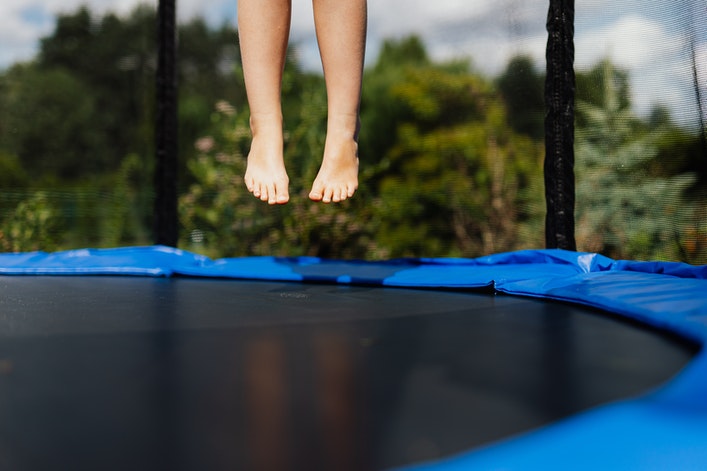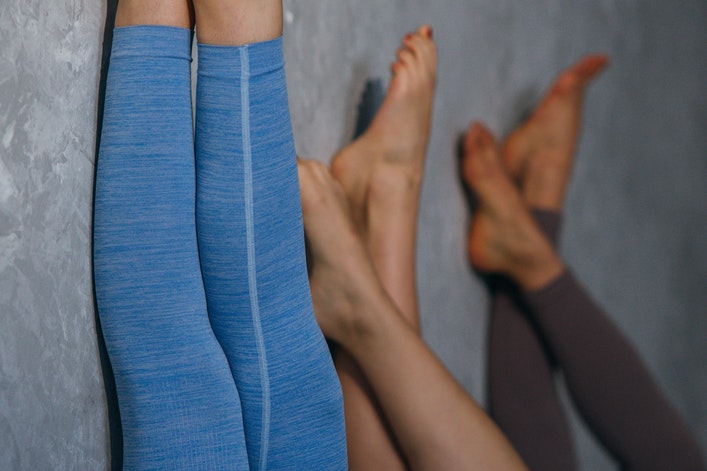If you have this condition, you’re probably constantly looking for ideas about lymphedema exercises. Rebounding is one that is easy to add and can help slow and manage its progression. So in this article we’ll talk about lymphedema exercises and why rebounding is something you should consider adding if you’re not already doing it.
I’ve found rebounding to be an indispensable part of natural lymphedema control in the past. I recently spotted a study that confirms rebounding can help lymphedema, so I wanted to share it.
Study on Lymphedema Exercises: Rebounding as a Treatment
This study recruited 30 people with upper or lower limb lymphedema who were not receiving any other treatment for the condition but were otherwise in good health. They were instructed on doing three weekly sessions of rebounding for 12 weeks. Their lymphedema was evaluated with measurements at the end of the 12 weeks. This particular researcher found a 56.6% improvement in the rebounding group, while the “control” group only improved about 6%.
I am not a medical person or researcher, and I also didn’t see further details, but that sounds like a significant improvement with really no potential downside.
You can read the complete study here:
How Does Rebounding Help Lymphedema?
As you’ve probably read, the lymphatic system does not have a “pump .”Instead, our activity is what moves lymph throughout the body. So your lymphatic system is totally dependent upon your movement every day.
Many of us sit a lot and work on computers in today’s sedentary world. Accordingly to Dave Scrivens, Certified Lymphologist in Canada, if we don’t get up and move frequently, “we leave our cells stewing in their own waste products and starving for nutrients.”
Does anyone remember Scared Straight? Yikes!
Seriously though, he says that too little movement not only makes our lymphedema worse by minimizing circulation it also can contribute to arthritis, cancer and other degenerative diseases.
That’s where rebounding comes in.
Rebounding is unique since it goes far beyond our movement from walking or running. It adds “G forces,” which, according to Mr. Scrivens, can increase lymph flow by 15 to 30 times.
While other exercises usually move us horizontally—i.e., walking, rebounding moves your body vertically. That’s the direction lymph moves naturally since lymph vessels run from the bottom of your legs to your head (and down your arms). Apparently, the up and down movement on the trampoline is ideal for getting lymph moving.
Other Benefits of Rebounding as a Lymphedema Exercise
Turns out, rebounding is quite powerful. Here are other benefits:
- Strengthens bones while being low impact
- Stimulates all your internal organs and all cells of your body
- Moves spinal fluid and all the fluid in your body
- Improves balance
- Detoxifies your body
- Improves your immune system
All the while you get a low impact cardio workout which is great for fitness as well as weight loss.
Not All Lymphedema Exercises are Created Equal
Another key benefit is that rebounding is a fast and efficient way to exercise. According to several articles on the topic, 20 minutes of rebounding equals 1 hour of running.
On busy days, this can make staying healthy so much easier.
Incorporating Rebounding Into Your Day
The best part? For me, it’s easy, fast and entertaining. I have a home gym and a spinning bike, rower and paddler that I rarely use. I prefer outdoor exercise, and hiking, walking, and biking are my daily exercise instead. I wish I enjoyed using those stationary machines, but I get so incredibly bored with them.
I don’t find that with the rebounder. I find it actually fun and look forward to it.
I keep it short to keep consistent, so I just do 10 minutes a day as a mid-morning workout. I actually look forward to it; it is an ideal break that leaves me with way more energy.
There are high-end rebounders out there, but I’ve had good luck with cheap ones too. Previously, I had an approx. $59 one that I bought online that lasted a few years but needed to be replaced after alot of use. Later I bought one at a sporting good store. Both have done well and I simply replaced the old one when it started showing signs of wear.
Updated 11/4/2022–please note that I recently replaced my mini trampoline with a new one. It is fantastic! I spent more, but it is unbelievable how much better of an experience it is and how much more of a circulation boost I’m getting, which is great for lymphedema. Now I recommend the JumpSport 430 ($329 on Amazon) –which I have been using, or the less expensive version, the JumpSport 220 ($239 on Amazon) as great choices and I have updated this blog accordingly.
First, the bounce is so soft that you can feel the increased circulation you get, without more effort. It is a real trampoline, and feels very different from the cheaper ones which are harder to bounce on. You had to do the work on those. On this wonderful JumpSport, the trampoline just helps you bounce more, which is what gets your lymph moving.
This one is extremely soft on your joints. I can bounce for 20 minutes and it feels good. Your ankles don’t get tired, which I would feel on the cheaper ones.
Finally, this JumpSport 430 has a bigger base and solid feet. It just feels solid and there’s much more room to jump so you feel safer.
The result? I love it. It makes it a pleasure to jump on for a few minutes at a time, a few times per day. I wear my fitbit and my heart rate gets really high with little effort.
So for me, its a no brainer. My legs feel better with less swelling.
I bought the JumpSport 430, which I love. Looks like that one is no longer available, but this one has the same features. I especially love the curved legs as the base feels extremely solid when you jump.
JumpSport 350 in-Home Fitness Trampoline

I put the trampoline in front of the TV, watch a recorded show (Jeopardy does it for me 🙂 ) and the 10 minutes fly by. There’s certainly no reason not to do more, but I like to build habits by keeping things short so I can get multiple small bouts of exercise in all day. As a lymphedema exercise, rebounding is ideal in that way.
If you want to spend a bit less, this one looks almost as good, and has the wider legs for a more stable base too. This one looks great too!
JumpSport 250 Mini Trampoline

Need More Motivation?
If you’re not sold on rebounding yet, check out what James White, Ph.D., former director of research and rehabilitation in the physical education department at the University of California at San Diego (UCSD), has to say about it. He is the author of “Jump for Joy,” so it’s pretty easy to see he’s an advocate.
“Rebounding allows the muscles to go through the full range of motion at equal force. It helps people learn to shift their weight properly and to be aware of body positions and balance,” says White.
He believes that rebounding is more effective for fitness and weight loss than cycling, running or jogging. At the same time, there is less chance for injury (as long as you’re at least reasonably careful.)
I find it a great way to break up a workday since I work on a computer. Ten minutes here and there, in addition to another longer workout, walk or yoga, is something that you may find easy and fun to incorporate into your day-to-day life.
But after writing this article, I’m feeling this is even more important for general health. I will continue doing the 10 minutes a day routine when I can. Seems like a no brainer way to improve your general health and control lymphedema at the same time.
Please note: this post may include affiliate links that earn FightLymphedema.com a small commission, at no cost to you, to offset the costs of maintaining this website and content. Thank you for supporting our efforts.
Are you seeing results from rebounding? Share your experience in the comments!







Can you recommend a good rebounder for a small apartment for a person who weighs 165 lbs with lymphedema?
Hi Ellen,
Sorry, a bunch of comments went to spam along with yours! So sorry. Yes, there are many that are inexpensive that either fold, or are light and you can just put up against a wall when you are not using. This is one I”ve used and it has been fine for me. https://amzn.to/3JqLtrg. There are also ones with bars if balance is an issue. Let us know how it goes!
Thanks for your constant inspiration!
You are very welcome! Thanks for reading. 🙂